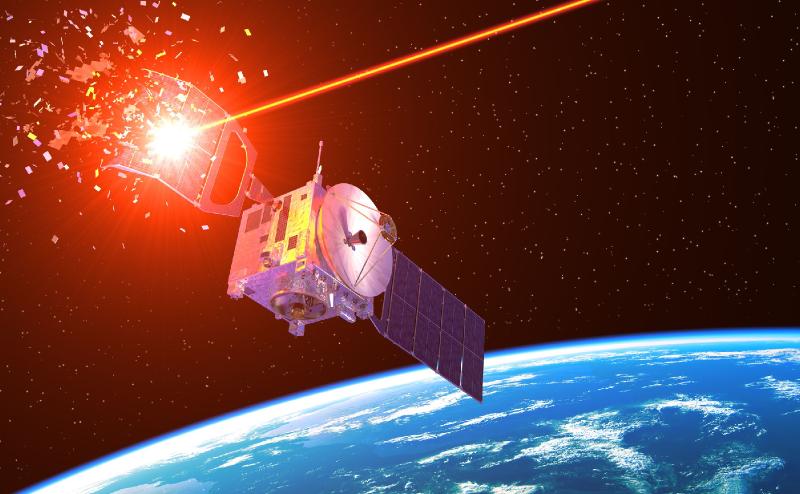The Space Force Is Calling for Space Weapons to Dominate the Final Frontier
By: Kyle Mizokami (Popular Mechanics)


Star Peace just wouldn't have the same visceral appeal as Star Wars. Who'd get excited over Henry Kissinger in space? Although Henry Kissinger could be considered a drone weapon if you've ever heard him lecture.

- A senior Space Force general is calling for the service to have its own "fires" in space.
- The call is for some kind of weaponry, likely based in space, capable of firing on targets on Earth or in space.
- None of the spacefaring powers have so far placed weapons in space, but it is probably only a matter of time until someone does.
The head of Space Command has called for the United States to develop what he calls "space fires"—a clear reference to some kind of weapons system. General Stephen Whiting stated that the U.S. must develop these weapons to ensure "space superiority" over adversaries, deter others from attacking American space assets, and use them operationally in the event of war. While space has remained free of weapons for the better part of a century, a new Cold War with China and Russia could quickly result in orbital weaponry sooner than anyone expects.
Decoding the Language

A Japanese 120mm towed mortar firing in an example of "indirect fires". The term "fires" not only applies to ground weapons but to air, sea, and now space weapons.
According to Air & Space Forces Monthly , Whiting made the comments at the Army Space & Missile Defense Symposium in Huntsville, Alabama. He did not elaborate on what "space fires" might be, what they might be targeted at, or how the U.S. might develop them.
"Fires" is a military term for the use of weapon systems to create specific lethal or nonlethal effects on a target. "Indirect fires," for example, is an Army term for artillery fire, such as the act of firing a 155mm high explosive shell from a howitzer. Fires might refer to the deployment of kinetic projectile weapons such as rifle fire, tank fire, aircraft bombs, missiles, rockets, or anything else meant to harm an enemy. It might refer to the use of lethal or non-lethal weapons, and can also refer to the use of non-kinetic weapons that operate using the electromagnetic spectrum—from lasers that shoot down drones to powerful jammers that disrupt an enemy's ability to use radar, communications, or even satellite-based capabilities.
"Superiority" refers to when one side dominates a particular domain (like air, sea, or space) to the extent that it has the freedom to do whatever it wants-albeit at risk and cost. "Air superiority," for example, means that an air force can fly virtually any place it wants to go—though it might still be opposed. ("Air dominance" is a step above, and refers to when an air force can do whatever it wants at little to no risk or cost, such as in the war in Afghanistan.) In this case, it seems like the fires (whatever they are)would be aimed at enemy space assets to prevent them from achieving space superiority.
If this logic holds, and it seems pretty clear, Whiting's comments are a call for anti-satellite weapons to join the Space Force's inventory.
Holding the Enemy at Risk

The Space Force's Remote Modular Terminal is designed to jam enemy satellite communications. Strictly speaking, it can be considered a "fires" weapon.
Star Trek famously described space as "the final frontier." Mankind's venture into space has long been peaceful—though most industrialized countries have military satellites for intelligence gathering, communications, navigation, and other missions. Aside from survival firearms meant to keep astronauts safe on Earth and a single Soviet 23mm automatic cannon that was tested once , the final frontier has remained free of actual weapons.
That won't hold forever. The global space economy was worth an estimated $630 billion in 2023 , and the benefits of commercial satellites (especially communications, GPS, and weather prediction) reach into the lives of virtually every person on the planet. Military satellites—though unarmed—are obvious targets, whose destruction would limit the abilities of the armies that operate them. The growing importance of space means that someone, somewhere will eventually get their "space fires."
Space satellites, caught in predictable orbits high above the Earth, are easily visible to radar and electro-optical sensors. The extreme speeds at which objects travel in orbit (about 12,000 miles an hour) mean that even tiny projectiles can do a staggering amount of damage to a man-made object. All of this implies that satellites are more or less equally vulnerable—at least, for now.
This shared vulnerability leads to a certain logic borrowed from nuclear war: mutually assured destruction. Once one space power develops anti-satellite weapons, the rest will quickly follow suit. The rest must follow suit, if only to deter hostile powers from attacking their space assets by holding enemy satellites at risk.
Space Fighters

A carrier rocket carrying the last satellite of the BeiDou Navigation Satellite System blasts off from the Xichang Satellite Launch Center in southwest China's Sichuan Province, June 23, 2020.
Space superiority weapons could take many different forms. Location is one issue: the weapon could be based on Earth or in space. Earth-based weapons have an advantage in that they can be concealed until the moment they are used, ensuring some level of surprise. The downside is that they can only be used against satellites directly. As a result, a ground-based anti-satellite weapon may have to wait hours to engage a passing satellite, or require repositioning elsewhere on the globe to achieve an intercept.
The Pentagon already has some Earth-based weapons, including the SM-3 interceptor (carried aboard Navy cruisers and destroyers), the Army's Ground-Based Interceptors (located in Alaska and California), and the Space Force's satellite jammers (capable of interfering with enemy satellite communications). This suggests that the general is thinking of something new, and that means a space-based system.
There are several ways that satellites can attack one another—each method with its own set of advantages or disadvantages. One is to use a projectile weapon, like a space-going shotgun, to blast another satellite with a cloud of metallic pellets. While effective, a space shotgun would require the attacker to get within close range of the target, which would likely be noticed by the target's operator. Another is to use a laser to render a satellite's functions (like communications antennas or electro-optical cameras) inoperative. A laser has the advantage of an instantaneous attack, but also requires a great deal of stored electrical energy.

In 2009, NASA astronauts repaired the Hubble Space Telescope. Future repairs to satellites will likely be done by robotic spacecraft...that also have the capability to inflict harm on enemy satellites.
Satellites might even engage in hand to hand (or robotic claw to claw) combat. With an average cost in the hundreds of millions , satellites are expensive , and engineers worldwide are investigating ways to repair malfunctioning satellites in orbit. Any satellite that can repair another satellite can probably break it. The disadvantage is that a satellite would have to saddle right up to its target, leaving little ambiguity as to who conducted the attack.
In aerial warfare, opposing sides struggle for air superiority with aircraft designed to shoot down enemy aircraft, otherwise known as fighters. Space-based anti-satellite weapons—at least, the reusable kind—will be the fighters that will vie for space superiority. Will we ever see the likes of X-wings and T.I.E. fighters? A hundred years ago, the fabric and plywood Sopwith Camel was armed with machine guns and dueled at just at 100 miles an hour over the trenches of World War I. Today, fighters invisible to radar can shoot down enemy planes at 100 miles, spy on enemy forces, and bomb ground targets with precision all in the same mission. What "fighters" will look like after 100 years of warfare in space is anyone's guess.
Kyle Mizokami is a writer on defense and security issues and has been at Popular Mechanics since 2015. If it involves explosions or projectiles, he's generally in favor of it. Kyle's articles have appeared at The Daily Beast, U.S. Naval Institute News, The Diplomat, Foreign Policy, Combat Aircraft Monthly, VICE News, and others. He lives in San Francisco.




No, no, we gotta blast 'em with boy toys. That's what's needed to revel in patriotic jargon, win medals, and retire with combat pay. That's how a four star middleman can get rich. All it takes is boatloads of taxpayer money.
You know we've been down this road before. But everyone has either forgotten or doesn't want to remember the history. First there was conducted under the auspices (or cover) of the International Geophysical Year in 1958. Then there was conducted in 1962 because the Russkies wouldn't agree to a moratorium on atmospheric testing on technical and verification grounds. (The USSR was afraid they couldn't detect continued testing by the US. The USSR really did have more capable scientists but lacked the needed engineering and manufacturing capability. Politics definitely hampered the USSR.)
Insanity.
Weapons tend to be used, at least once.